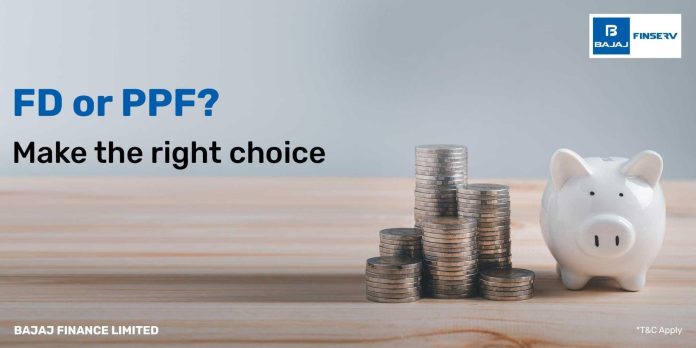You have worked tremendously hard to save money for future expenses. However, piling cash in a savings account is never considered wise, as savings accounts provide interest rates between 3% and 7% on average. Since these interest rates are lower or slightly above the current inflation rate, you may lose money value over time. As earning individuals already know that they must invest a healthy portion of their saved money to earn better returns than a savings account, they look towards various investment instruments available in the market.
However, one of the core concerns while investing in investment instruments is the risk attached to every investment instrument. Almost every individual who makes an effective investment portfolio allocates a portion of the capital amount to fixed-income instruments such as fixed deposits with the highest FD rates and Public Provident Funds (PPFs).
If you want to create an effective investment portfolio, comparing two of the most popular fixed-income instruments is important. As far as FDs are concerned, Bajaj Finserv FDs come with the highest FD rates. This article will help you compare Bajaj Finance FDs with PPF investments to get the best returns on your investments.

What Are Fixed-Income Investments
All Heading
Fixed-income investments such as FDs and PPFs are investment instruments that pay regular, predetermined interest to the investors and promise to pay the initial principal amount back at the time of maturity. Entities such as banks, governments, and corporations issue fixed-income instruments to raise money from the public. These entities use the investment you make for various internal purposes and, against your investment, promise to pay you regular interest and return the principal at maturity.
Fixed-income instruments differ from market-linked instruments such as shares and mutual funds, as a fixed-income instrument’s performance is generally not based on the current market trend or condition. Hence, fixed-income instruments come with very low risk as compared to market-linked instruments. However, fixed-income instruments such as FDs may offer different interest rates based on the issuer bank or NBFC, making it important to invest after extensive comparison.
What Is A Fixed Deposit
A fixed deposit is an investment instrument offered by banks and other NBFCs that offers investors a regular interest payout at regular intervals. The interest payout is based on a predetermined interest rate and an internal payout, given on the initial principal amount invested by the investor. Every FD has a set maturity date, which investors can increase at the time of maturity if they want to hold the FD for a longer period. If not, they get the principal amount along with all the added interest amount as a lump sum.
Key Features of FDs:
- Deposit: Investors are required to invest a lump sum amount, which generally starts from Rs. 5,000 and has no upper maximum limit. Every FD product may have different minimum amount requirements.
- Fixed Interest Rate: The bank or the financial institution offers a fixed interest rate on the deposit amount until the maturity of the FD.
- Interest Payments: Non-cumulative FDs pay interest at regular intervals, such as monthly, quarterly, semi-annually, and annually. Cumulative FDs compound the interest and pay the whole amount at maturity, depending on the terms agreed upon.
- Taxation: Interest earned from fixed deposits is taxable. Some specific types of FDs, such as tax-saving FDs, offer tax benefits under certain conditions.
- Safety: Fixed deposits are considered safe investments as they offer guaranteed returns and are generally insured up to a certain limit.
Bajaj Finance Fixed Deposits: FDs with the Highest FD Rates
FDs are one of the most important additions to an effective financial plan as they provide generally risk-free returns with compounded interest and the promise of principal repayments. Among numerous banks and financial institutions, Bajaj Finance stands out with its FDs, offering one of India’s highest FD rates. In general, Non-Banking Financial Companies (NBFCs) such as Bajaj Finance offer higher FD rates than traditional banks, and within NBFCs, Bajaj Finance offers one of the highest FD rates.
Here are the key reasons why Bajaj Finance FD is an ideal fixed-income product:
- Highest Interest Rates: Bajaj Finance Digital FDs come with one of the highest FD rates in India. You can start investing with just Rs. 15,000 and get returns based on an industry-high interest rate of 8.65% per annum. Furthermore, Bajaj Finance FDs offer special interest rates for specific tenures.
- Highest Safety Ratings: Credit rating agencies rate every FD based on the issuer’s ability to pay regular interest and principal without any default. Bajaj Finance FDs have the highest safety ratings, with CRISIL AAA/STABLE and [ICRA] AAA/STABLE, ensuring guaranteed returns.
- Payout Options: Bajaj Finance offers both cumulative and non-cumulative interest payout options. You can choose cumulative payouts to accumulate interest on the amount as a lump sum at maturity. On the other hand, you can choose non-cumulative interest payouts to receive regular interest payouts and earn a steady income.
- Wide Range of Tenures: Bajaj Finance has designed its FD products to come with a wide range of FD tenures. You can choose from a range of flexible tenures between 12 and 60 months and ensure you can achieve both short-term and long-term goals.
- Loan Against FD: One of the most unique features of Bajaj Finance FD is that you can avail of a loan against the FD. Bajaj Finance offers a quick loan of up to 75% of the deposit value in case of cumulative FDs and 60% in case of non-cumulative FDs.
What Are PPFs
Now that you know about fixed deposits, the next step is to learn about another popular fixed-income instrument. Public Provident Funds (PPFs) are investment instruments offered by the Indian government to provide regular interest payouts and tax benefits to investors. The government sets the interest rate on PPF, which is reviewed quarterly. The interest is compounded annually and credited to the account at the end of the financial year. The current interest rate on PPF is 7.1%, and investors can make contributions to their PPF account in lump sum or instalments. The minimum annual contribution is Rs. 500, and the maximum is Rs. 1.5 lakh per financial year.
Key features of PPFs:
- Tenure: The PPF has a minimum lock-in period of 15 years. After the lock-in period is over, investors can extend the tenure further in blocks of 5 years.
- Account opening: You can open a PPF account at designated nationalised banks, post offices, and some private sector banks.
- Tax benefits: Contributions to PPF are eligible for tax deductions under section 80C of the Income Tax Act. The interest earned and the maturity amount are also tax-free (Exempt-Exempt-Exempt status).
- Loan and withdrawal: You can take a loan against the PPF balance from the 3rd to the 6th year. Furthermore, you can partially withdraw funds from your PPF account from the 7th year onwards.
- Account Closure: You can prematurely close your PPF account after 5 years under specific conditions such as higher education or serious illness.
Difference Between FDs and PPFs
Here is a detailed table depicting the difference between FDs and PPFs:
| Aspect | Fixed Deposits (FDs) | Public Provident Funds (PPFs) |
| Issurer | Banks and Non-Banking Financial Companies (NBFCs) | Government of India |
| Tenure | Ranging from 7 days to 10 years or more | Fixed at 15 years, extendable in blocks of 5 years |
| Interest rate | Fixed but different across banks and NBFCs | Fixed by the government after quarterly review |
| Safety | Insured up to Rs. 5 lakh per bank under DICGC | Fully backed by the Government of India |
| Interest Payments | Periodic (monthly, quarterly, annually) or on maturity | Compounded annually and credited at the end of the financial year |
| Tax Benefits | Interest is taxable, but tax-saving FDs offer deductions under section 80C | Contribution amount, interest earned, and maturity amount are tax-free under section 80C (EEE status) |
| Minimum and Maximum investment |
|
|
| Interest Rates | 5% to 10% | Lower interest rates. The current interest rate being 7.1% |
Bajaj Finance FDs vs PPF: Which Is Better
The answer to choosing between Bajaj Finance FDs with the highest FD rates and PPF depends entirely on your investment goals. For example, suppose you want to have more liquidity and wish to realise cash quicker. In that case, you can choose Bajaj Finance FDs, as PPFs have numerous restrictions on premature and general withdrawal. PPFs do not offer any withdrawal before 5 years, that too, for specific reasons, while you can choose FDs with a tenure of just 1 year with Bajaj Finance.
Furthermore, if you aim to build wealth and multiply your investment amount, Bajaj Finance FDs are a better option as they offer the highest FD rates of 8.65% p.a. compared to the current 7.1% p.a. offered by PPFs. This means that you get better returns with Bajaj Finance FDs when compared to current PPF investments.
Additionally, you can choose from a range of tenures, with Bajaj Finance FD tenures ranging from 12 months to 60 months. On the other hand, PPFs do not have such flexibility and only offer the scheme with a lock-in period of 15 years.
However, if your goal is to invest for the long term (a minimum of 15 years) and you also want tax benefits to lower your taxable income, you can choose PPFs as your investment option.

Conclusion
Fixed-income instruments are essential for a balanced and diversified financial plan as they come with lower risk than other market-linked investment instruments. Two of the most popular fixed-income investment instruments are FD and PPFs, which can offer steady returns with considerably lower risk. However, if you have to choose between the two, FDs come out as a better option, especially when invested in Bajaj Finance FDs. They offer the highest FD rates with the most flexible tenures, providing higher returns and liquidity than PPF investments. However, you can choose PPFs if you want to avail of tax benefits and are looking for longer investment tenures than 15 years.
In case you want to open an FD, look no further than the Bajaj Finance Digital FDs. Visit the Bajaj Finserv website today to book your fixed deposit.












Recent Comments